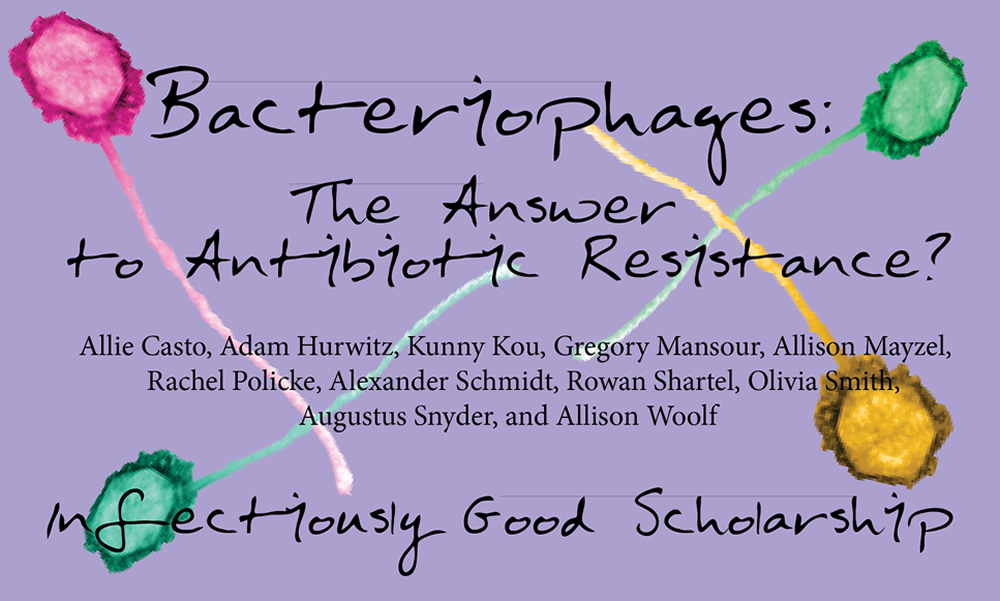In a World Where Eleven Undergraduate Students Can Co-author a Biology Paper . . .
News
SUMMARY: Antibiotics are losing the war against bacteria, and scientists' best weapon may be a century-old approach. Bacteriophages, bacteria-infecting viruses, offer a promising alternative in this group-authored literature review.
In a world where antibiotics are losing the war against bacteria, scientists are developing new approaches for concerns ranging from preserving food to treating chronic diseases.
Bacteriophages, viruses that infect bacteria, offer a promising alternative to antibiotics in scientific and medical fields. The researchers of Dr. Louise Temple’s Spring 2015 Viral Genomics honors seminar examine this promise in “Bacteriophages: The Answer to Antibiotic Resistance?”
In the first life sciences article published in JMURJ, Hayley Norian offered a data-driven bioinformatics approach to bacteriophages. The eleven authors of “Bacteriophages: The Answer to Antibiotic Resistance?” come at the issue differently, collaborating to create an expanded literature review that surveys the history of phage therapy, why U.S. government agencies have been hesitant to endorse the field, and possible applications and directions for researchers going forward.
JMURJ has always welcomed group submissions—we published a capstone report co-written by four Engineering students in Volume 1—but we wanted to know more about how the students in Dr. Temple’s class worked as a team and how they filled their different roles.
“We initially outlined our paper as a comprehensive literature review of phage therapy,” Augustus Snyder said, “We then divided into pairs and delegated specific topics.” Even as each pair developed its portion of the project, the whole team needed to know what everyone else was doing. Gregory Mansour wrote that “We utilized a Google Docs-like program where we brought together all our ideas. In addition, we had regular classes where we shared our research and provided criticisms for each other.”
After the teams finished their initial drafts, the paper needed editing. Snyder remembered that “Olivia Smith was responsible as ‘team editor’ and largely kept track of the compilation of sources and use of citations, aided by RefWorks. The compiled document underwent multiple rounds of both group revision as a whole and individual revision of particular sections before submission to JMURJ.”
Completing any task could have been complicated and chaotic for such a large group, but the team collaborated effectively. For Kunny Kou, “It was a good learning experience. My fellow group members and I were punctual, patient, and consistently communicated. Overall, Dr. Temple was the glue that kept us together.”
We also wanted to know how the scholars in Dr. Temple's Viral Genomics class felt about having their work published in JMURJ, For Snyder, “the attention and approval that comes with undergraduate publication” added additional meaning and value to the work he did with the team. Adam Hurwitz was pleased that “the hard work and dedication we put into researching and collaborating on the paper will be seen by others.”
Other students offered insight into how working through the publication process and being published might benefit their future careers. Olivia Smith, one of three team members not majoring in biology, said that “Though the paper itself doesn't really have much to do with the field I'm going into, I'm thrilled that this is something I can put on my graduate school applications to show I have a body of knowledge and experience outside my chosen career path.”
The final note goes to Alexander Schmidt, who hoped that he and his fellow researchers can replicate the publication experience: “Seeing our paper published in JMURJ serves as a reminder of what our futures may hold in the scientific field. It makes being a science major much more real, having gone through a process that we will likely undergo many times in the future.”
Read “Bacteriophages: The Answer to Antibiotic Resistance?” in Volume 3 of JMURJ.
____
Allie Casto (’15), from Staunton, VA, majored in biotechnology.
Adam Hurwitz (’18), from Woodbourne, NY, is a biology major on the pre-medicine track.
Kunny Kou (’16) is a biology major from Fairfax, VA.
Gregory Mansour (’17) is a health sciences and biology double major from Haymarket, VA.
Allison Mayzel (’16) is biology major and Spanish minor from Upton, MA.
Rachel Policke (’17) is a chemistry major from Forest, VA.
Alexander Schmidt (’18), from South Riding, VA, is a biology major on the pre-medicine track. He works in Dr. Justin Brown’s Neuroscience Research Lab.
Rowan Shartel (’17) is a biology major from Annandale, VA.
Olivia Smith (’18) is an anthropology major from Harrisonburg, VA, with a concentration in archaeology.
Augustus Snyder (’18) is an honors biology major on the pre-secondary education track from Fincastle, VA.
Allison Woolf (’18) is a nursing major and chronic illness minor from Lynchburg, VA.
